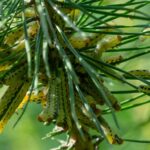Conifer Sawfly
Sawflies
Conifer sawflies are a group of insects that belong to the family Tenthredinidae. They are known for their voracious appetite and ability to defoliate conifer trees, including species such as pine, spruce, and fir. The larvae of these insects feed on the needles of the tree, leaving behind a distinctive "windowpane" damage pattern. The damage caused by conifer sawflies can lead to reduced tree growth and overall tree health, and in severe cases, the death of the tree.
Adult conifer sawflies are typically small, black or brown insects that resemble wasps. They have long, slender bodies and clear wings, which they use to fly from tree to tree in search of new food sources. The female sawflies lay their eggs on the needles of conifer trees, and when the eggs hatch, the larvae begin to feed on the needles.
There are many species of conifer sawflies, each with slightly different life cycles and habits. Some species feed on only one species of tree, while others are more generalist feeders. Some species feed on the needles in the spring, while others feed later in the year. The timing of their feeding can impact the severity of the damage caused, as early-season feeding can reduce the tree's ability to produce new growth for the rest of the year.
Control of conifer sawflies can be challenging, as the larvae are well-protected within the needles of the tree. Chemical treatments can be effective, but timing is critical and repeated applications may be necessary. In some cases, biological controls such as natural predators, such as birds and parasitic wasps, can provide effective control. Cultural practices, such as proper irrigation and fertilization, can also help trees to recover from sawfly damage and become more resistant to future attacks.
In conclusion, conifer sawflies can cause significant damage to conifer trees, leading to reduced tree health and growth. It is important to monitor for the presence of these insects and implement appropriate control measures to minimize the damage caused.



